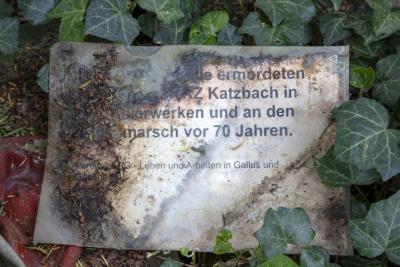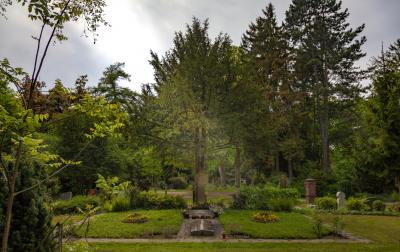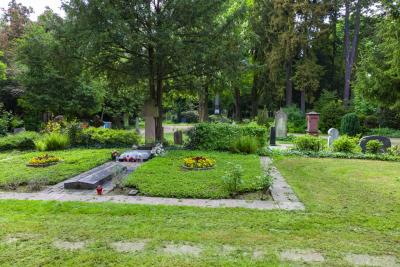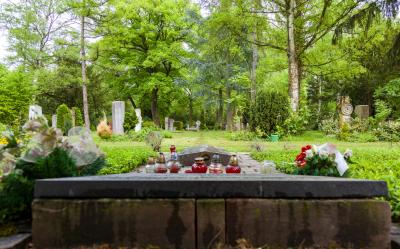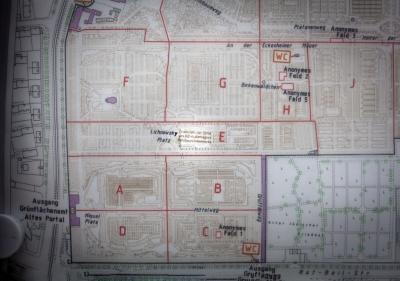The collective grave of the 528 prisoners of Katzbach concentration camp in the Adlerwerke
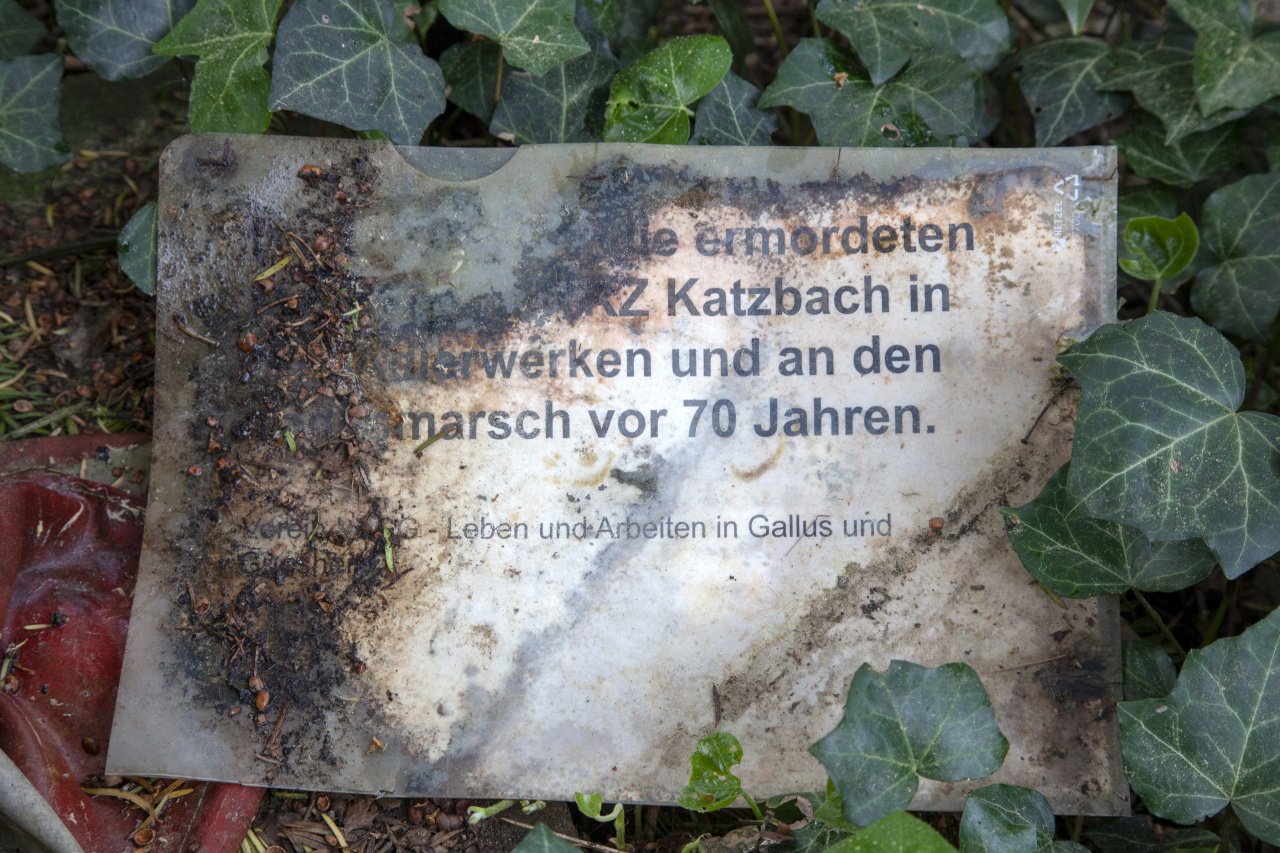
The collective grave of the 528 prisoners of Katzbach concentration camp in the Adlerwerke in Frankfurt am Main
The Adlerwerke in Frankfurt am Main was badly damaged by the allied air strikes in 1944. To counter the labour shortage in arms production, the company recruited prisoners from concentration camps. To this end, 1,000 detainees were quartered in barracks on the third and fourth floors of the factory in the Frankfurt suburb of Gallus. This camp, the “Katzbach” camp, was administratively subordinate to the Natzweiler-Struthof concentration camp in Alsace. The command kept a 25-man SS unit under the orders of SS Hauptscharführer Erich Franz. The Adlerwerke also deployed support units which were mainly made up of SA storm troopers. Otherwise, the prisoners were overseen by 300 civilian factory workers.
On 22 August 1944, a command of 200 prisoners arrived in the Adlerwerke from Buchenwald concentration camp. The prisoners were mostly Poles who had been involved in the Warsaw Uprising, as were the 1000 prisoners that Dachau concentration camp had assigned on 29 September 1944. The Katzbach camp operated extermination by labour resulting in up to 20 people losing their life each day. These losses were replaced by new arrivals. On 26 January 1945, 167 prisoners were brought to the camp. Most of these prisoners had also taken part in the Warsaw Uprising and, up to that point, had been exploited in the Daimler-Benz camp in Mannheim-Sandhofen, which had been destroyed. On 1 February 1945, a further 225 prisoners from Auschwitz-Jawischowitz and Buchenwald concentration camps arrived in Frankfurt. From this date, the cohort of prisoners in the Katzbach camp was made up of eight different nationalities. With the allied front approaching, production in the Adlerwerke was stopped on 23 March 1945. One day later, around 360 prisoners began the evacuation march, which was later to be referred to as the death march. The first stage finished at Buchenwald. From there, they continued on to Dachau. Of the 1,600 prisoners, only around 50 survived to the end of the war.
Mortality rate in Katzbach concentration camp
528 prisoners who died in the Adlerwerke or near the factory were to find their last resting place in the collective grave in the main cemetery in Frankfurt am Main. Almost all of them were Poles, with at least 11 probably hailing from Russia and the Ukraine. Whilst the camp had its own infirmary, it only had 20 beds, which meant that the sick and weakened inmates were selected. 245 prisoners were taken to the infirmary in Vaihingen and were de facto transported to their death.
The air raid on 6 January 1945 cost 62 prisoners in the Katzbach camp their lives. They had been incarcerated in a miserable cellar which was hit by a bomb. The last big selection took place just before the evacuation march. 500 prisoners, who were unable to march, were transported in railway wagons to Bergen-Belsen concentration camp; only eight of them survived the journey. Yet more prisoners, around 300 in number, died on the death march or in the quarantine in which they were placed in the destinations camps.
The most frequent causes of death in the Katzbach camp, as noted in the cemetery book, were tuberculosis, damage to the cardiac muscle or blood poisoning, whilst those who survived the camp talk of malnutrition and hypothermia for want of warm clothing. After the war, the prisoners also spoke of brutal abuse at the hands of the SS and the concentration camp guards; abuse which also frequently resulted in death. Eight cases of shooting and hanging are known from the files, although the authors Kaiser and Knorn cannot rule out that such killings were more frequent. The public executions, floggings and detention sentences in the bunker were used to intimidate prisoners. And so it happened that the prisoners Wincenty Bocheński and Władysław Sumara were hanged on 24 January 1945 for alleged sabotage. The same fate awaited Ukrainian Georgij Lebedenko and the Russian Adam Golub on 14 March 1945. Both escaped from the camp, but were betrayed by the residents in the neighbourhood around the Adlerwerke soon after. Katzbach concentration camp had the highest mortality rate of all 28 concentration camps and sub-camps in Hesse.
[1] Ernst Kaiser, Michael Knorn, “Wir lebten und schliefen zwischen den Toten”. Rüstungsproduktion, Zwangsarbeit und Vernichtung in den Frankfurter Adlerwerken, Frankfurt, New York 1998 (3rd extended and updated edition), p. 221.
[2] Ernst Kaiser, Michael Knorn, Obóz w sercu miasta, [in:] Katzbach – obóz widmo. Powstańcy warszawscy w Zakładach Adlera we Frankfurcie nad Menem 1944-45, Karta, Warszawa 2016, p. 4 and: Ernst Kaiser, Michael Knorn, “Wir lebten und schliefen zwischen den Toten”. Rüstungsproduktion, Zwangsarbeit und Vernichtung in den Frankfurter Adlerwerken, Frankfurt/New York 1998 (3rd extended and updated edition), p. 213.
[3] Ibid, p. 219.
The design of the grave site
The increasing awareness of the crimes committed in the Katzbach camp and the growing need to remember its victims, have meant that the collective grave of the 528 camp inmates has changed over the years. In the beginning, the grave site was looked after by Poles who had remained in Germany after the war. From the 1970s, more and more Frankfurt residents became involved in preserving the memory until the local NGO Leben und Arbeiten in Gallus und Griesheim e.V. (LAAG) took over the care of the site. The memorial has been expanded to include new elements and, through this example, the decades of effort for the victims can be understood – a true archaeology of remembrance.
In 1948, the mortal remains of the prisoners of Katzbach concentration camp were moved to the current grave site in the main cemetery. The Polish Catholic Mission erected a stone cross there with a relief of Christ on the cross bearing the inscription “Ofiarom niemieckich obozów koncentracyjnych 1948 – Rodacy” (To the victims of the German concentration camps 1948 – The compatriots). It was decided that a direct reference to the place where the deceased had been imprisoned, the Katzbach camp in the Adlerwerke, would not be provided. This mass grave was marked on the plan of the cemetery as “Polish war graves”. The voluntary work on the freshly created grave sites was carried out by five Poles, who were given a few days off from their vocational construction college to carry out the work. In 1972, the Hesse Ministry of the Interior had the resting place bordered with stone slabs on which all the first names and surnames of the 528 victims of Katzbach concentration camp were engraved. Most of the names were Polish in origin. From that time forward, the victims were no longer anonymous. However, there was still no mention of the place where they died. The stone slabs were laid so that they form a rectangular surround of the grave section. Extensive greenery was planted in 1974.
In 1986, a commemorative plaque donated by the Frankfurt section of the Bundes der Polen Zgoda e. V. and bearing a Polish-German inscription was added in front of the stone cross. The universal inscription reads: “Ofiarom niemieckich obozów koncentracyjnych. Den Opfern des Faschismus” [“To the victims of Fascism”], although the German translation differed significantly from the inscription from 1948. There was still no explicit reference to the camp. After Ernst Kaiser and Michael Knorn’s extensive monograph was published in 1994 under the title “’Wir lebten und schliefen zwischen den Toten’. Rüstungsproduktion, Zwangsarbeit und Vernichtung in den Frankfurter Adlerwerken”, which was based on years of scientific research, the Leben und Arbeiten in Gallus und Griesheim e. V. (LAGG) association took over the care of the grave site in 1995. The two independent Frankfurt historians studied their sources carefully and evaluated them thoroughly. Their work and their reference to the collective grave housing 528 prisoners ensured that Katzbach concentration camp found its way back into the public consciousness.
The grave site was renamed in 1997 on the initiative of the LAGG association. It is now called “Grabstätte der Opfer des KZ-Außenlagers Katzbach/Adlerwerke” [“Grave site of the victims of the Katzbach/Adlerwerke concentration sub-camp”]. The association has also donated a memorial stone. The competition to design the stone was advertised in 1996 with the Initiative gegen das Vergessen [Initiative against forgetting]. The contract was won by the Frankfurt artist Dirk Wilhelm Bührmann. His design is rooted in Greek humanism and Jewish traditions thanks to his selection of symbolism which is reminiscent of camp slavery. The inauguration of the memorial stone took place in 1997 in the presence of former prisoners of Katzbach concentration camp who had travelled from Warsaw.
[4] See: https://kz-adlerwerke.de/de/orte/grab/einleitung.html (last retrieved on: 22/05/2018)
Bührmann’s memorial stone took the form of a sarcophagus with slightly inclined lid faces; a tomb design typical of Ancient Greece and Ancient Rome that was predominantly reserved for prosperous, deserving citizens. The design symbolically gives the victims their dignity back, a dignity which had been taken from them in the camp. The sarcophagus has purposely been sunk into the ground slightly. This is supposed to give the observer the impression that an unknown force is pushing it out of the ground. This moment also stands for emerging from obscurity and for passing on the memory of the crimes in Katzbach concentration camp to subsequent generations. The proportions of the sarcophagus are those of a traditional Jewish coffin. The head and foot are endowed with circular reliefs arranged symmetrically. On one side is a loaf of bread, something that the prisoners longer for the most during their months in camp hell. On the other side is a butterfly, a symbol for the souls of the deceased rising to Heaven. On both of the slightly inclined lid faces are the following inscriptions engraved in German and Polish:
In memorial
Here lie 528 people
They died between August 1944 and March 1945 in the Adlerwerke,
in Frankfurt am Main. They were exterminated by work, forced labour.
They starved to death, died of exhaustion, of untreated illnesses,
were beaten to death. They died in the middle of Frankfurt.
The Adlerwerke was a sub-camp of the Natzweiler concentration camp.
The womb he crawled from is still going strong.
Bert Brecht
Joanna de Vincenz, June 2018
Most recently, the City of Frankfurt put up an information board next to the sarcophagus on which a pictogram is depicted and the following two websites are provided:
Both websites were created under the leadership of the Institut für Stadtgeschichte and are edited and added to continuously under scientific supervision.
Literature:
De Vincenz, Joanna, Powstaje miejsce pamięci o byłym niemieckim obozie Katzbach, Deutsche Welle article dated 13 May 2018, online: http://www.dw.com/pl/powstaje-miejsce-pami%C4%99ci-o-by%C5%82ym-niemieckim-obozie-katzbach/a-43747010
Ernst Kaiser, Michael Knorn, “Wir lebten und schliefen zwischen den Toten”. Rüstungsproduktion, Zwangsarbeit und Vernichtung in den Frankfurter Adlerwerken, Frankfurt/New York 1998 (3rd extended and updated edition)
Katzbach – obóz widmo. Powstańcy warszawscy w Zakładach Adlera we Frankfurcie nad Menem 1944-45, Ośrodek KARTA, Warszawa 2016
Joanna Skibińska, Die letzten Zeugen. Gespräche mit Überlebenden des KZ-Außenlagers “Katzbach” in den Adlerwerken Frankfurt am Main, Hanau 2005
Websites:
https://kz-adlerwerke.de, including a directory of the names of the victims that found their last resting place in the collective grave. The Internet presence is maintained by the Initiative gegen das Vergessen and by the Verein Leben und Arbeiten im Gallus und Griesheim (LAGG). (last retrieved on: 22/05/2018
http://www.gedenkorte-frankfurt-main.de/
Zwei Balkone, documentary by Andrzej Falber, 2004, 45 minutes, online: https://www.youtube.com/watch?v=wp5PFETKrrU
